Temperature measurement equipment
Introduction to Temperature Measurement
Temperature can be measured via a diverse array of sensors. All of them infer temperature by sensing some change in a physical characteristic. Six types with which the engineer is likely to come into contact are: thermocouples, resistive temperature devices (RTDs and thermistors), infrared radiators, bimetallic devices, liquid expansion devices, and change-of-state devices.
Choose the right temperature measurement instrument for your application
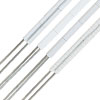 Thermocouple Temperature Measurement Sensors
Thermocouple Temperature Measurement Sensors
Thermocouples consist essentially of two strips or wires made of different metals and joined at one end. Changes in the temperature at that juncture induce a change in electromotive force (emf) between the other ends. As temperature goes up, this output emf of the thermocouple rises, though not necessarily linearly.
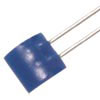 Resistance Temperature Devices(RTD)
Resistance Temperature Devices(RTD)
Resistive temperature devices capitalize on the fact that the electrical resistance of a material changes as its temperature changes. Two key types are the metallic devices (commonly referred to as RTDs), and thermistors. As their name indicates, RTDs rely on resistance change in a metal, with the resistance rising more or less linearly with temperature. Thermistors are based on resistance change in a ceramic semiconductor; the resistance drops nonlinearly with temperature rise.
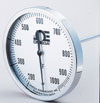 Bimetallic Temperature Measurement Devices
Bimetallic Temperature Measurement Devices
Bimetallic devices take advantage of the difference in rate of thermal expansion between different metals. Strips of two metals are bonded together. When heated, one side will expand more than the other, and the resulting bending is translated into a temperature reading by mechanical linkage to a pointer. These devices are portable and they do not require a power supply, but they are usually not as accurate as thermocouples or RTDs and they do not readily lend themselves to temperature recording.
 Fluid-Expansion Temperature Measurement Devices
Fluid-Expansion Temperature Measurement Devices
Fluid-expansion devices, typified by the household thermometer, generally come in two main classifications: the mercury type and the organic-liquid type. Versions employing gas instead of liquid are also available. Mercury is considered an environmental hazard, so there are regulations governing the shipment of devices that contain it. Fluid-expansion sensors do not require electric power, do not pose explosion hazards, and are stable even after repeated cycling. On the other hand, they do not generate data that is easily recorded or transmitted, and they cannot make spot or point measurements.
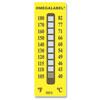 Change-of-State Temperature sensors
Change-of-State Temperature sensors
Change-of-state temperature sensors consist of labels, pellets, crayons, lacquers or liquid crystals whose appearance changes once a certain temperature is reached. They are used, for instance, with steam traps - when a trap exceeds a certain temperature, a white dot on a sensor label attached to the trap will turn black. Response time typically takes minutes, so these devices often do not respond to transient temperature changes. And accuracy is lower than with other types of sensors. Furthermore, the change in state is irreversible, except in the case of liquid-crystal displays. Even so, change-of-state sensors can be handy when one needs confirmation that the temperature of a piece of equipment or a material has not exceeded a certain level, for instance for technical or legal reasons during product shipment.
↓ View this page in another language or region ↓
 CLOSE
CLOSE



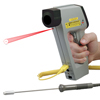




 Medición de Temperatura
Medición de Temperatura Medición de Temperatura
Medición de Temperatura Temperature Measurement
Temperature Measurement Temperaturmåling
Temperaturmåling Introduction à la mesure de température
Introduction à la mesure de température Temperaturmessung
Temperaturmessung Temperature Measurement
Temperature Measurement Sensor de temperatura
Sensor de temperatura Temperature Measurement
Temperature Measurement Temperature Measurement
Temperature Measurement 温度測定
温度測定 Temperature Measurement
Temperature Measurement 温度测量
温度测量 온도 측정
온도 측정 Temperature Measurement
Temperature Measurement
 Temperature Measurement
Temperature Measurement
 Temperature Measurement
Temperature Measurement
 Temperature Measurement
Temperature Measurement
 Temperature Measurement
Temperature Measurement